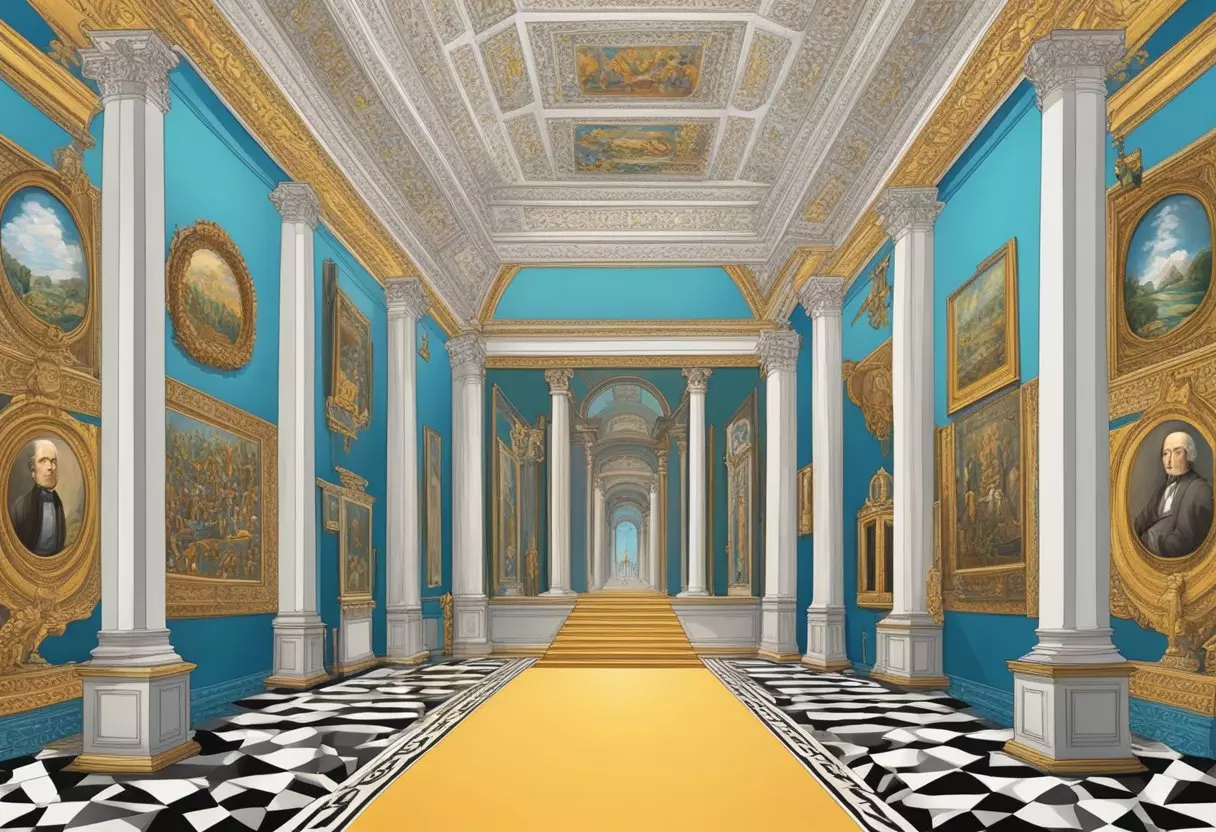The notion of symmetry has been a crucial element in art throughout history, employed to create balance, order, and harmony across various visual art forms. This is evident in symmetric sections which mirror each other’s traits. Artists utilize symmetry to formulate aesthetically pleasing compositions. A variety of symmetry types are seen in artwork, each uniquely contributing to the overall composition.
To fully appreciate art, it’s crucial to understand the role of symmetry. Evident in nature, architecture, and of course, art, symmetry is considered a fundamental geometric and mathematical concept. In art, symmetry facilitates balance, harmony, and order. Using symmetry, artists can create visual interest, bring into focus critical composition elements, and foster unity.
Symmetry: A Deeper Understanding
Diving into the Concept of Symmetry
In the realm of art, symmetry implies a balance achieved by arranging elements such that they mirror each other. It’s symmetry that empowers artists to instill harmony and order in their work. This fundamental concept has been active in the art world for centuries, leading to aesthetically pleasing compositions.
Symmetry is born when art elements align identically or almost identically. Multiple techniques can attain this balance, including the use of color, shape, size, or texture. The beauty of symmetry lies in its ability to craft a sense of harmony and balance.
Mastering the Types of Symmetry
Artists experiment with several types of symmetry in their work, including bilateral, radial, rotational, translational, reflection, inverted, and biaxial symmetry.
Bilateral symmetry, or reflectional symmetry, is a common type of symmetry in art. Created when an object is halved into identical or nearly identical halves, this form of symmetry is frequently applied in portraits, landscapes, and other art forms.
Radial symmetry, where an object is sectioned into equal parts radiating from a central point, is often used in mandalas, flowers, and other artistic pieces.
Rotational symmetry occurs when an object maintains its original form even when rotated around a central point. Geometric designs found in Islamic art often exhibit this form of symmetry.
Translational symmetry is exhibited when an object repeats in a pattern that shifts direction. Often found in textiles, wallpapers, and other decorative art pieces, this symmetry type adds a unique flair.
Reflection symmetry, also referred to as mirror symmetry, is crafted when an object is divided into two identical or nearly identical halves that mirror each other. This symmetry form is frequently used in sculptures and other three-dimensional art pieces.
Inverted symmetry appears when an object is reflected and then rotated. Often used in abstract art, this form of symmetry presents a unique visual interest.
Biaxial symmetry occurs when an object, usually natural forms or crystals, is divided into two identical or nearly identical halves that rotate at different angles.
Symmetry’s Role in Art History

Inherent to art for centuries, the concept of symmetry has evolved over time. This section will outline the use of symmetry across various eras in art history.
Antiquity and Symmetry
Symmetry held a special place in the art of numerous ancient cultures, including the Egyptians, Greeks, and Romans. For instance, ancient Egyptian art used symmetry to craft images of gods and pharaohs considered sacred. Ancient Greek art showcased significant usage of symmetry, creating a harmonious balance in their sculptures and architecture. Similarly, the Romans employed symmetry to cultivate a sense of order and balance in their monumental structures.
Symmetry in the Renaissance
The Renaissance period highlighted a revived interest in symmetry, especially in the works of Leonardo da Vinci. Da Vinci’s renowned painting, “The Last Supper,” exemplifies the use of symmetry in Renaissance art, featuring symmetrically arranged figures around Christ, the central figure.
Symmetry in Modern and Contemporary Art
In modern and contemporary art, symmetry has been employed in various distinctive ways. For instance, filmmakers like Stanley Kubrick and Wes Anderson have adopted symmetry to create visually striking scenes in their movies. David Alexander’s “Symmetry” series explores the use of symmetry within abstract art.
Artistic Balance and Symmetry
To sculpt a visually intriguing and harmonious work of art, balance and symmetry become two crucial elements for artists. Understanding balance becomes key in establishing stability and unity in art. This section will guide you through the various types of balance and symmetry in art.
Unraveling the Concept of Balance
Balance in art translates to the arrangement of elements to construct stability and unity. It calls for the distribution of elements’ visual weight to shape a balance. Visual weight quantifies the attention an artwork element draws. Therefore, a composition teetering on balance will distribute visual weight equitably, fostering harmony and stability.
Visual Balance and Weight
Visual balance is attained when the visual weight of artwork elements is evenly shared. Visual balance can manifest in symmetrical, asymmetrical, or radial forms.
Symmetrical balance unfolds when an artwork is partitioned into two equal halves, each mimicking the other. This balance establishes stability and order in artwork. An exemplary application of symmetrical balance in art is Leonardo da Vinci’s iconic painting, “The Last Supper.”
Conversely, asymmetrical balance occurs when the visual weight distributes evenly but doesn’t mirror. This balance induces a sense of energy and movement in an artwork. Vincent van Gogh’s “Starry Night” is a fascinating example of asymmetrical balance in art.
Radial balance is elicited when the visual weight in an artwork radiates from the central point or axis. Much like asymmetrical balance, radial balance induces a sense of energy and movement. Sandro Botticelli’s “The Birth of Venus” artfully demonstrates this.
Witnessing Balance in Art
Art boasts numerous instances of balance, involving both symmetrical and asymmetrical compositions. Notably, Pablo Picasso’s “Guernica,” a painting with a chaotic composition and unevenly dispersed visual weight, still manages to achieve a sense of balance and unity.
Conversely, Jan van Eyck’s “The Arnolfini Portrait” presents a symmetrical composition, with the central figure forming the focal point. Positioned on the composition’s central axis, this figure induces stability and order.
Designing with Symmetry
Symmetry, a fundamental design principle, has been entwined with art and architecture for centuries. Designers use symmetry for creating mirror images or repeated patterns to establish balance and harmony. They also rely on symmetry to enhance designs’ visual appeal and draw attention to specific elements. In this section, we’ll delve deeper into symmetry’s application in architecture, web and graphic design.
Symmetry’s Role in Architecture
Symmetry in architecture has been fundamental for centuries. Architects use it to create balanced, harmonious structures. Found across diverse architectural styles, from classical to modern, symmetry can establish a sense of order and stability in a building, drawing attention to certain features such as a central entrance or a domed roof.
Web and Graphic Design Embracing Symmetry
Web and graphic design share a fondness for symmetry. It helps create balance and harmony in design while drawing attention to specific elements. Symmetry is often instrumental in creating a clear, user-friendly web design layout and can exude an aura of professionalism and sophistication in designs.
Making Symmetrical Designs
Designing symmetrically can pose a challenge, but several tools and techniques simplify the task. One of the easiest methods to create symmetry is the use of a grid system, which helps designers maintain a consistent layout and proper alignment of design elements.
Another technique involves using symmetry tools integrated into design software. Many design tools, such as Adobe Illustrator, come equipped with built-in symmetry tools. These tools help designers create symmetrical patterns and shapes with ease.
Practical Application of Symmetry
Symmetry is a crucial element of art that evokes a sense of order and balance. Artists have used it in various forms throughout history. Here, we’ll explore the practical usage of symmetry in art and share best practices for creating symmetrical artworks.
Techniques and Best Practices for Symmetry
In art, symmetry evokes order and color balance. Achieving it by mirroring an image or a work of art along a central axis results in a perfectly symmetrical image. Interestingly, asymmetrical compositions can be just as effective as perfectly symmetrical ones when it comes to delivering aesthetically pleasing results.
When crafting symmetrical artwork, artists must consider factors such as the distribution of elements on the left and right sides of the image, light source, and the golden ratio. The last is a mathematical ratio that is commonly seen as aesthetically pleasing and can be used to establish symmetry in art.
Effective practices for creating symmetrical artwork include using the rule of thirds and the gestalt principles. The rule of thirds involves dividing the image into thirds both horizontally and vertically, with points of interest placed at the intersections, leading to a balanced and engaging composition. Gestalt principles help to create a sense of unity and completion in the artwork.
Symmetry in Artwork: Examples
Symmetry spans numerous artistic forms, revealing its ability to create order. Vincent Van Gogh’s “Starry Night,” with its symmetrical composition and central focal point, illustrates how symmetry can shape balance and harmony in art.
Examples also include black and white photography, which frequently uses symmetrical forms and compositions. Techniques like radial symmetry, which centers around symmetrical forms, can also achieve work that possesses balance.
Using Symmetry to Highlight
Artists can use symmetry to draw attention to specific points of interest in their work. By creating a symmetrical composition, artists can guide the viewer’s eye towards certain elements of the artwork. This can be achieved by placing these points of interest at the center of the composition or using color and contrast to create emphasis.
Frequently Asked Questions
What are examples of symmetrical shapes in art?
Balance and harmony in art are often achieved through symmetrical shapes. Circles, squares, triangles, and ovals are examples of symmetrical shapes, which artists use to create patterns and designs that are visually appealing.
How do symmetrical and asymmetrical balance in art differ?
Symmetrical balance in art pertains to a composition where both sides of a central axis mirror each other. In contrast, asymmetrical balance describes a composition where different elements on each side of the axis balance each other. The former exudes a more formal and traditional feel, while the latter can instill a sense of movement and energy.
What are the three types of symmetry in art?
Art recognizes rotational, plane, and point symmetry. Rotary symmetry means an object can be rotated around a point and still resemble its original appearance. Plane symmetry involves an object divisible into mirror-like halves. Point symmetry identifies with plane symmetry but with an added central point of symmetry.
What are famous examples of symmetrical art?
Countless examples of symmetrical art exist throughout history. Notably, the Taj Mahal’s symmetrical architecture and gardens, Leonardo da Vinci’s “Vitruvian Man” featuring symmetrical human proportions, and Greece’s Parthenon with its balanced columns and pediments, are testaments to symmetry’s influence in art.
What role does symmetry play in artwork?
Symmetry plays an integral role in artwork, establishing balance, harmony, and order. It aids in crafting patterns, designs, and visually appealing compositions. Beyond aesthetics, symmetry can also convey deeper meanings and symbolism in art, like the use of balanced shapes in religious art to symbolize harmony and balance.
How can artists create symmetrical drawings or paintings?
Artists can create symmetrical artwork by crafting compositions that are perfectly balanced on each side of a central axis using symmetrical shapes, patterns, and designs. They can also introduce asymmetrical elements within symmetrical compositions to create a sense of dynamism and movement.
In conclusion, symmetry is a fundamental concept in art, creating a sense of balance, harmony, and visual appeal. Its utilization in various art forms and historical periods underscores its significance in constructing visually pleasing compositions. Moreover, understanding the different types of symmetry provides artists with a powerful tool to weave a sense of unity, stability, and dynamism into their work. With its practical application in architecture and design, along with its academic application in geometry and mathematics, symmetry truly bridges the gap between science and art.

